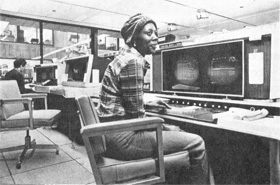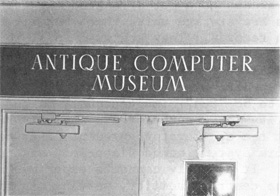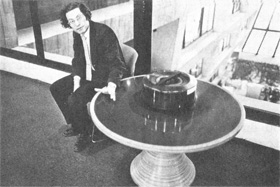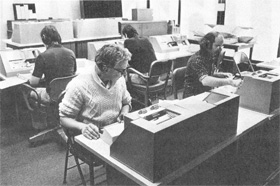Computing Department Increases Capacity
A Fermilab visitor to the Central Laboratory (seventh floor west), after stepping off the elevator and walking straight ahead through a work area, encounters this tastefully lettered sign: "ANTIQUE COMPUTER MUSEUM." Al Brenner, computing department head, admits the sign isn't literally true but indicates the general vintage of the Laboratory's general purpose computing facilities. The sign was designed and lettered by artist Angela Gonzales. If the visitor walks through the doors under the sign he enters a batching area--a workroom for sorting computer printouts. Above an exit at the room's opposite end is another sample of Angela's handiwork. This sign reads: "Ye Olde Machine Shop." The machines are Fermilab's major computers. They include two Control Data Corporation 6600's and a newcomer, a CDC 6400. Recent computing facility improvements have been outlined for The Village Crier by the department head.
Not one to rest on his "antiques," Brenner plans to replace the obsolete computers with more modern hardware. Earmarked for that purpose is a $12,000,000 budget request for fiscal year 1978 (starting October 1). Updated computer facilities are being sought. According to Brenner, the new hardware will increase Fermilab computer throughput to three to four times current levels while holding operating costs about the same. Congress must pass President Carter's proposed budget before Fermilab can begin the modernization process.
In the meantime, the Laboratory is making-do with interim measures. "New equipment is needed to relieve our totally saturated condition," Brenner said. "Laboratory computers operate 24 hours a day, seven days a week, except for preventive maintenance and repairs. Central computing facilities have operated at a saturated level for the past year. A major limitation on the quantity and quality of the physics studies conducted here is the capacity of computing facilities available. We presently have the capacity to analyze only about 10 to 20 per cent of experimental data generated here. That capacity is appreciably less than comparable laboratories with lower energy accelerators and smaller experimental programs," he said.
Providing some relief is the recently-acquired CDC 6400, dubbed machine C since it was installed in tandem with A and B, the veteran 6600 machines. C was purchased second-hand from the used computer marketplace. "A" was transferred to Fermilab in 1973, "affectionately," from Lawrence Berkeley (California) Laboratory according to a brass commemorative plaque on the computer. "B", also a pre-owned model, was discovered in an electronic flea market and put on stream in 1975. Computer "C's" distinction is that it serves as a "front end" -- coordinator for A and B. It provides input, output, and utility functions for her bigger, faster sisters. Other attributes of C are: 65,000 words of central memory; access to 500,000 word extended core storage memory; and a processor with about 40 per cent of the speed of the 6600's. (B machine, by the way, was improved by the addition of 65,000 words of memory capacity. The increase doubled its former capacity and brought B up to parity with machine A.)
C is also able to do non-setup compilations and execute small programs. Should failure or maintenance shut down one or two of the trio, the survivor computers can pick up some of the load to allow production to continue on a reduced scale. All three machines have access to a set of shared magnetic storage discs. Discs are storage units that look like big phonograph records. They are used to store data collected from magnetic tapes used by experimenters and other information read into or generated by the computer. Multi-programming capability permits several computer jobs to be "run" simultaneously in one machine. High priority jobs -- such as data analysis for experiments using the accelerator -- preempt other projects. A network system, named Bison-Net, was installed last year. It directly connects experimental computers to the central facility, serving experimenters whose magnitude of computing needs exceed the capacity of local on-line computers.
Other new equipment includes six CDC model 84441 high-speed disc drives. These machines read the data stored on magnetic discs. This is the first set of disc drives to be installed at Fermilab. With the new drives, disc storage capacity was dramatically increased. New tape drives were also added to the system, giving extra capacity for tape reel storage access. Last summer, the system for allocating and accounting for user computer service was instituted. Users, numbering from about 150 year-round to as many as 300 during summer months, are charged for computer services provided. Users are billed $200 per hour for computer time, an average charge covering operation and maintenance.








